.

Voyager 1 Encounters Saturn
Contents
- Foreword 1
- Introduction 3
- The Planet 4
- The Rings 12
- The Satellites 20
- A Glimpse Back 32
- The Voyager Mission 36
- MISSION OBJECTIVES 36
- SPACECRAFT CHARACTERISTICS 36
- SATURN ENCOUNTER 36
- Scientific Highlights 38
- SATURN 38
- RINGS 38
- NEW SATELLITES 38
- INNER SATELLITES 38
- TITAN 39
- OUTER SATELLITES 39
- MAGNETOSPHERE 39
- Scientific Investigations 40

COVER: Saturn and two of its moons, Tethys (above) and Dione (below), were photographed by Voyager 1 on November 3, 1980, from 13 million kilometers (8 million miles). The shadow of Tethys is cast onto the cloudtops in the upper right corner of the image.
Foreword
The pictures assembled in this publication are a part of the rich and varied harvest of information returned by Voyager 1 across nearly a billion miles of interplanetary space. These images are of great beauty as well as great scientific interest, serving to remind us of the awesome and breathtaking dimensions of the solar system we inhabit. Voyager is providing intriguing new information which should help us to understand how the Earth—and possibly the universe—was formed. Already there have been surprises and puzzles that paint a completely new picture of Saturn and its neighborhood, including the discovery of three new moons, startling information about Saturn’s rings, and observation of the unexpectedly complex structure of Saturn’s atmosphere and that of its largest moon, Titan. It will take years for scientists to assimilate completely the information which is cascading down from Voyager. What more will this marvel of technology have to tell us before it departs the solar system to travel endlessly among the stars?
Robert A. Frosch, Administrator National Aeronautics and Space Administration December 1980
The date of each photograph and the distance of the spacecraft from the planet or satellite are included with each picture.
For sale by the Superintendent of Documents, U.S. Government
Printing Office, Washington, D.C. 20402
Stock No. 033-000-00817-1

Voyager 1 was launched from Cape Canaveral, Florida, on September 5, 1977, beginning its journey to Jupiter, Saturn, and beyond.
Introduction
No other generation has had the opportunity or the technology to reach beyond our world—to see, to touch, to hear the forces that shape our universe. In slightly over two decades, man has ingeniously explored five distant planets—and two dozen moons. We have seen their weather and surfaces, landed on some, probed the atmospheres of others, and listened to their radio noises.
Under the planetary exploration program of the National Aeronautics and Space Administration, the Voyager Mission, begun in 1972, was designed to explore Jupiter, Saturn, their satellites, rings, magnetic fields, and interplanetary space. Two automated, reprogrammable spacecraft, Voyagers 1 and 2, were launched in late summer of 1977. Their goals: the outer planets.
Both spacecraft made astounding discoveries in the Jupiter system in 1979—a thin ring, a thick ionized sulfur and oxygen torus, an actively volcanic satellite—these were but a few of the treasures yielded by the two Jupiter flybys.
Now, Voyager 1 has completed exploration of its final target: the ringed planet Saturn and its enigmatic giant satellite, Titan. True to the generally unpredictable nature of planetary exploration, the treasures of the Saturn system far exceeded all expectations. We learned more about Saturn in one week than in all of recorded history, thanks to one trusty robot no larger than a compact car and to thousands of diligent and imaginative people.
Both spacecraft carry an assortment of optical, radiometric, and fields and particles sensing instruments. Taken together, their data present a comprehensive picture of a planetary system—and clues to what is happening, what has happened, and what may happen in our universe.
This publication presents the preliminary photographic results of Voyager 1’s encounter with Saturn and its major satellites. Voyager 1 transmitted over 17,500 images in its four months of close observations of the system. Many of these images have been combined to produce mosaics and color pictures. Hundreds have yet to be closely examined.
The second Voyager spacecraft will begin its close Saturn observations in early June 1981 and make its closest approach to the planet’s northern hemisphere on August 25. Then, due to its launch during a period of rare planetary alignment occurring only once every 175 years, Voyager 2 will be able to continue on to a rendezvous with the seventh planet, Uranus, in January 1986, and perhaps even the eighth planet, Neptune, in August 1989.
Voyager 1’s primary mission is complete. But its usefulness is far from over. As we go about our daily business, Voyager 1 is searching for another frontier—the edge of our solar system. In 7 to 15 years, the spacecraft will cross the heliopause—the farthest reaches of our Sun’s magnetic field influence. Then, high above our ecliptic plane, Voyager 1 will continue its flight toward the star Alpha Ophiuchus. Eventually, Voyager 1 will be too distant to communicate with Earth and will silently drift in space forever.
Andrew J. Stofan, Acting Associate Administrator for Space Science National Aeronautics and Space Administration
The Planet

11/5/80 9 million km (5.5 million mi)
Saturn is the sixth planet from the Sun and second largest in our solar system. Like Jupiter, it is a giant sphere of gas—mostly hydrogen and helium—with a possible core of rocky material. Various features in Saturn’s cloudtops are visible in the accompanying color-enhanced image of the planet’s northern hemisphere: small-scale convective cloud features (similar to, but much larger than, thunderstorms in Earth’s atmosphere) are visible in the brown belt; an isolated convective cloud with a dark ring is visible in the light brown zone; and a longitudinal wave is visible in the light blue region.

9/17/80 76 million km (47 million mi)
As Voyager 1 approached Saturn, a series of dark and light cloud bands (belts and zones) became apparent in the planet’s northern hemisphere through a high altitude atmospheric haze. The planet’s shadow obscures the rings behind and immediately to the east of the disk. In addition, the shadow of the rings on the planet’s disk can be seen just north of the rings themselves as they cross in front of the planet. Six of Saturn’s 15 known satellites are visible. Saturn’s largest moon, Titan (considerably larger than Earth’s moon), is clearly visible in the upper left corner. The smaller satellites Dione, Tethys, and Rhea are shown in the lower left corner (upper, middle, and lower, respectively). Two of the innermost moons, Mimas and Enceladus, appear to the right of the planet (Mimas is the one closer to the planet). These six moons orbit Saturn in the equatorial plane and appear in their present positions because Voyager is above that plane.
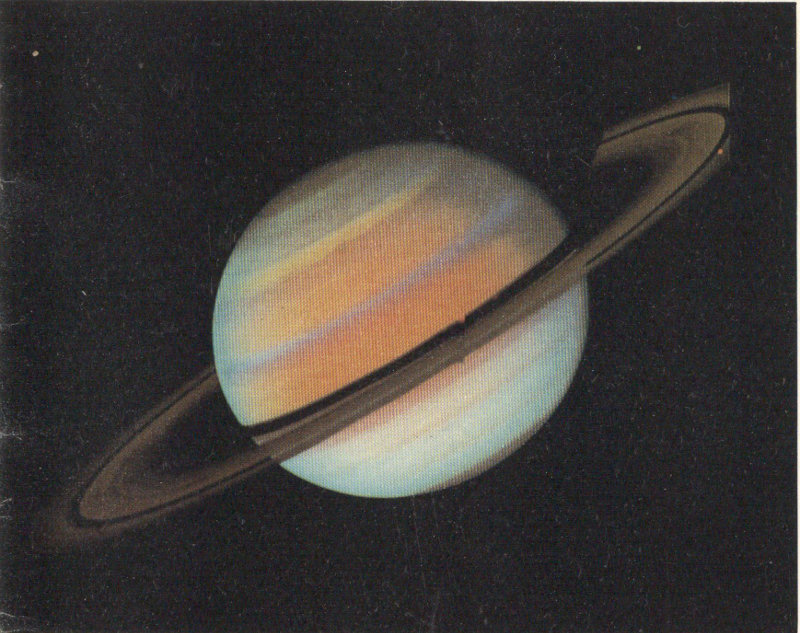
10/18/80 34 million km (21 million mi)
The North Temperate Belt is visible as the violet-colored belt in this false-color photograph. In this image, features which are especially bright in ultraviolet light appear as turquoise and violet, while ultraviolet-dark areas appear orange. Notice in particular the three spots (two bright orange and one pale violet) at mid-northern latitudes. The bright spots are similar to those shown at much higher resolution in later images. The distinct color difference between the North Equatorial Belt and Saturn’s other belts and zones may be due to a thick haze layer covering the northern portion of the belt. It is not yet understood why the southern hemisphere of the planet (below the rings) appears bluer than the northern hemisphere. Color spots in the rings are artifacts of image processing.
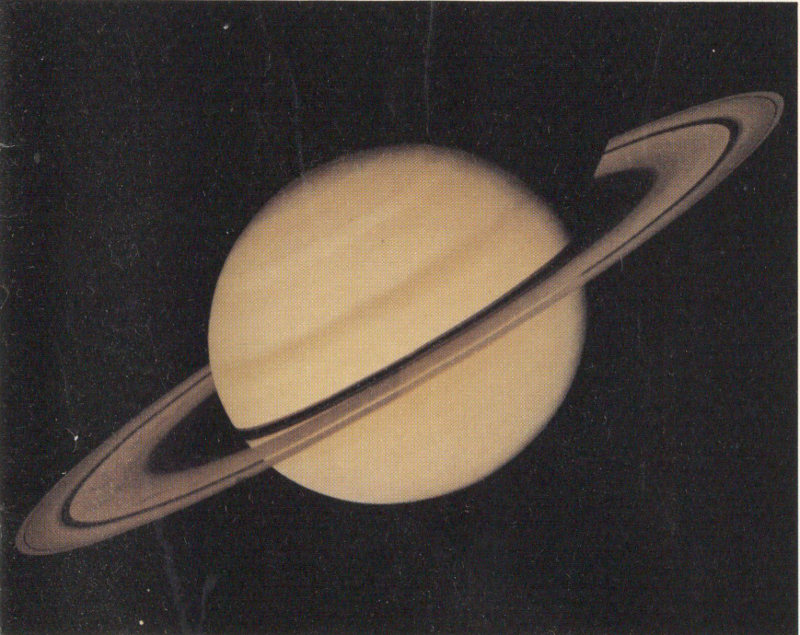
10/30/80 18 million km (11 million mi)
Saturn’s soft, velvety appearance and previously unseen detail in its mysterious rings became visible as Voyager 1 approached the planet. For example, a gap in the dark C-Ring is now visible, and material can be seen within the relatively wide Cassini Division (long believed to be empty), which separates the B-Ring (middle) from the A-Ring (outer). The Encke Division appears near the outer edge of the A-Ring. Detail can be seen within the shadow cast by the rings upon the planet: the broad, dark band near the equator is the shadow of the B-Ring; the thinner, brighter line just to the south is the shadow of the less dense A-Ring. Three of Saturn’s moons, Tethys (outer left), Enceladus (inner left), and Mimas (right) are also visible in this computer mosaic of Voyager 1 images.

11/6/80 8.5 million km (5.3 million mi)
An unusual red oval cloud feature, similar to (but smaller than) Jupiter’s Great Red Spot, was discovered in the southern hemisphere of Saturn. The oval, 6000 kilometers (4000 miles) in length, is located at 55 degrees south latitude. The difference in color between the red oval and the surrounding bluish clouds in these two false-color images indicates that material within the oval contains a substance that absorbs more blue and violet light than the bluish clouds. Voyager scientists first observed the oval in August 1980, and the feature has retained its appearance since its discovery.
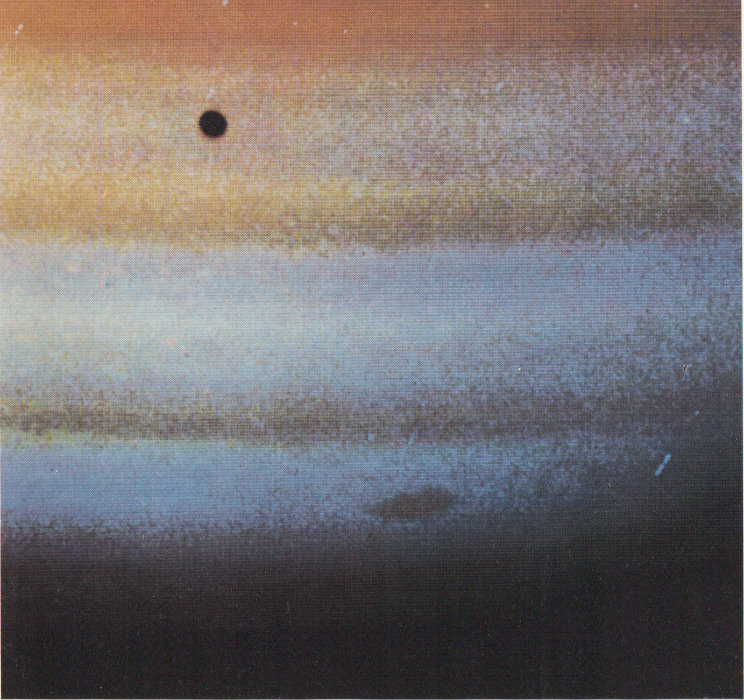
11/6/80 8 million km (5 million mi)
In this photograph, the shadow of the satellite Dione is seen as a dark circle on the face of the planet.

11/10/80 3.5 million km (2.2 million mi)
A ribbon-like wave structure and small convective features marking a westward jet stream above the wave are visible in this photograph of Saturn’s cloudtops. The view, extending from 40 degrees to 60 degrees north latitude, shows features 65 kilometers (40 miles) in diameter. Measurements in images such as this one indicate that Saturn has fewer east-to-west wind currents than does Jupiter.
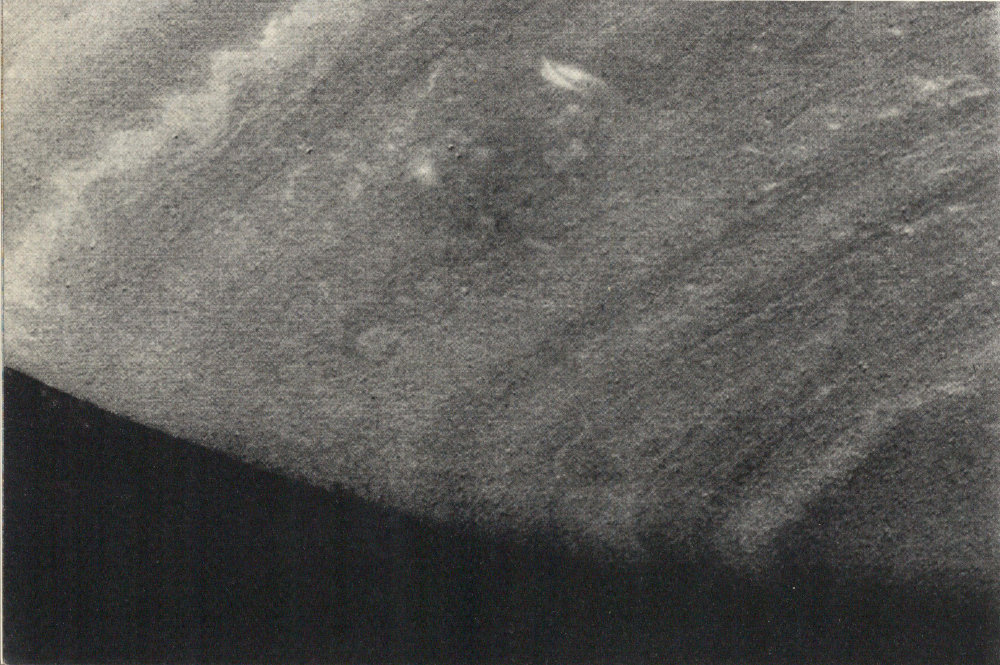
11/12/80 442,000 km (265,000 mi)
Numerous small cloud features were photographed as Voyager 1 passed above Saturn’s southern hemisphere. At these polar latitudes, the large-scale light and dark bands break down into small-scale features, seen here as waves and eddies.
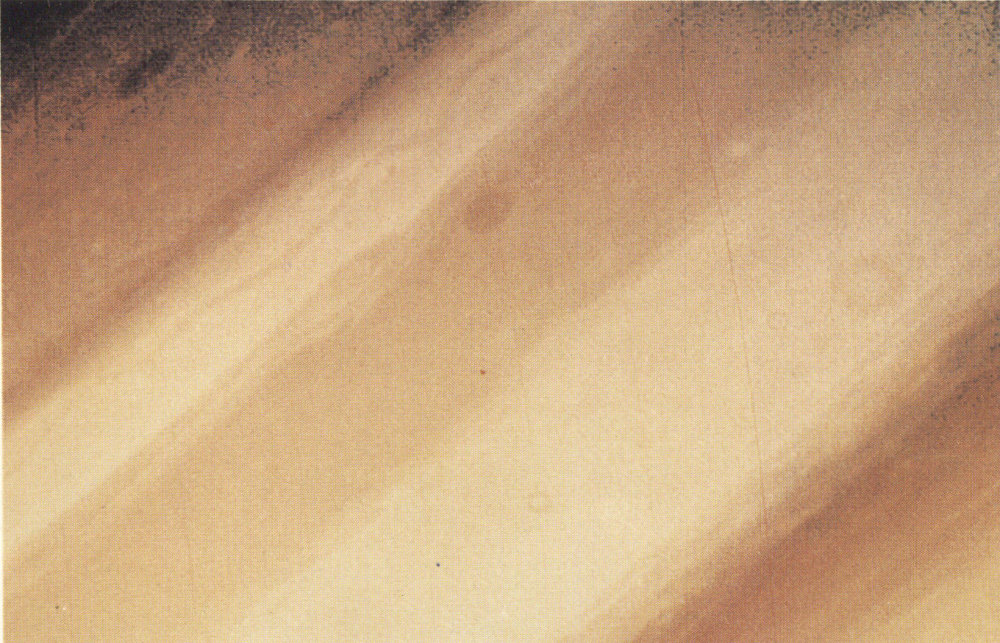
11/7/80 7.5 million km (4.6 million mi)
Two brown ovals, approximately 10,000 kilometers (6000 miles) across, were discovered in Saturn’s northern hemisphere, at about 40 degrees and 60 degrees latitude. The polar oval (upper left) has a structure similar to Saturn’s red oval located in the southern polar latitudes. Detail within the ovals is not visible at this resolution, so it is not yet known if they are rotating features similar to the many spots in Jupiter’s atmosphere.
The Rings

11/12/80 717,000 km (444,000 mi)
The rings of Saturn have amazed and intrigued astronomers for over 300 years. Now that we have seen them up close, they are even more astonishing. Although they stretch over 65,000 kilometers (40,000 miles), they may be only a few kilometers thick. The ring particles—from a few microns to a meter (three feet) in size—have been described as icy snowballs or ice-covered rock. Voyager scientists continue to pore over their data, searching for answers to the puzzles of the rings. The rings were named in order of their discovery, so the labels do not indicate their relative positions. From the planet outward, they are known as D, C, B, A, F, and E.

10/25/80 24 million km (15 million mi)
Extraordinarily complex structure is seen across the entire span of Saturn’s ring system. The sequence (taken approximately every 15 minutes as Voyager 1 approached Saturn) proceeds from top to bottom in each column and shows radial “spokes” rotating within the B-Ring. The spokes may be caused by a combination of magnetic and electrostatic forces.
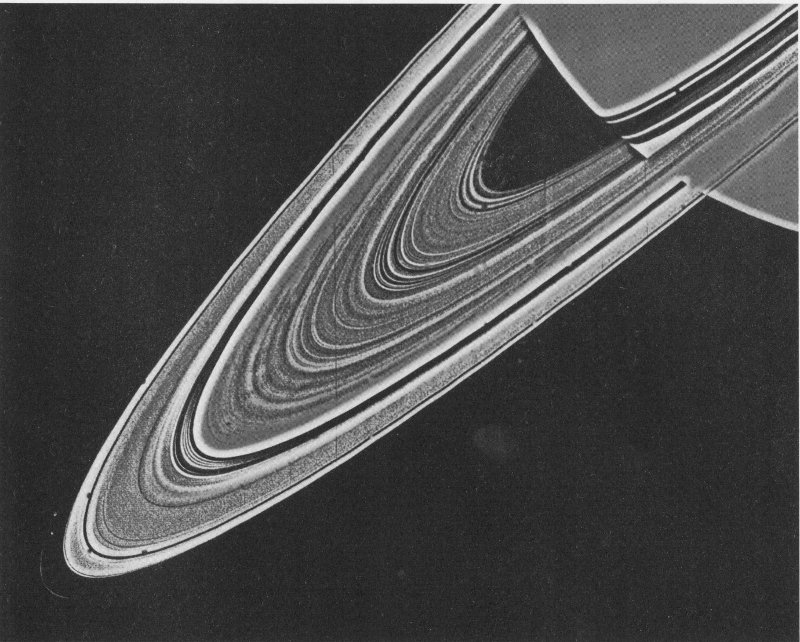
11/6/80 8 million km (5 million mi)
Over 95 individual concentric features can he counted; the final count in higher resolution images may be anywhere from 500 to 1000 separate rings. A few of the ringlets shown in this computer-assembled mosaic are not concentric circles but are instead elliptical. Ring particles are probably ice or ice covered rock.
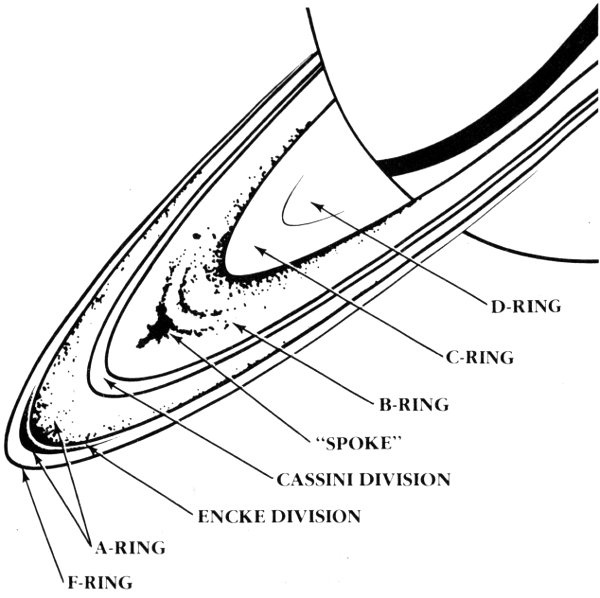
The classic features of the rings are illustrated in the diagram.
- D-RING
- C-RING
- B-RING
- “SPOKE”
- CASSINI DIVISION
- ENCKE DIVISION
- A-RING
- F-RING

11/8/80 6 million km (3.7 million mi)
The Cassini Division is filled with numerous ringlets. Discovered by Cassini in 1675, this area between the A- and B-Rings had long been thought devoid of material. The Voyager observation of well-defined rings within the Cassini Division was an unexpected discovery.
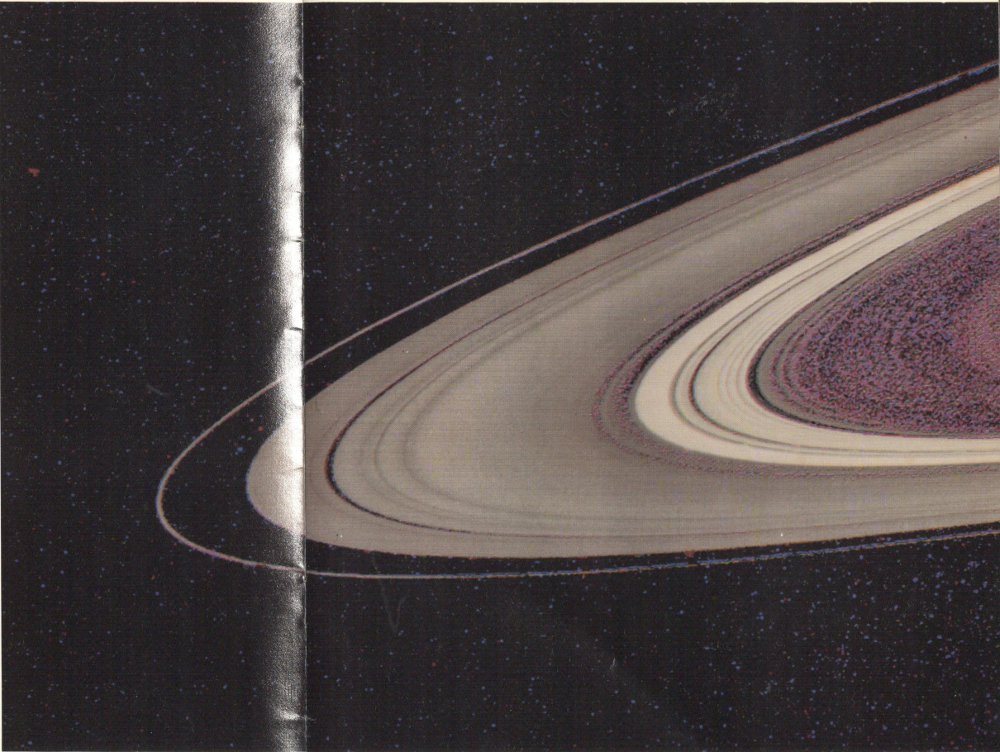
11/12/80 740,000 km (460,000 mi)
Saturn’s ring system, viewed from below, appears dramatically different from its appearance on the sunlit side. This computer-processed image shows the F-Ring circling outside the A-Ring, the A-Ring with its Encke Division, the multiple ringlets in the Cassini Division, and the optically thick B-Ring, seen here in magenta hues (the coloration is an artifact of processing and is not real). The B-Ring appears dark from below the ring plane because it is dense enough to reflect most of the sunlight, causing it to appear very bright when seen from the sunward side. The opaline brightness of the Cassini Division here indicates a great deal of sunlight being scattered through this region. The Encke Division may really be empty, since it appears dark from both above and below.

11/12/80 720,000 km (450,000 mi)
Outbound and above the ring plane, Voyager 1 gave us this view of Saturn’s rings eight hours after its closest approach to the planet. The unique lighting accentuates the many hundreds of bright and dark ringlets comprising the ring system. The C-Ring (dark gray area) seems to blend into the brighter B-Ring as the concentric features radiate out from the planet. The dark spoke-like features seen in images taken during the approach to Saturn now appear as bright streaks, indicating that they may be composed of small particles.
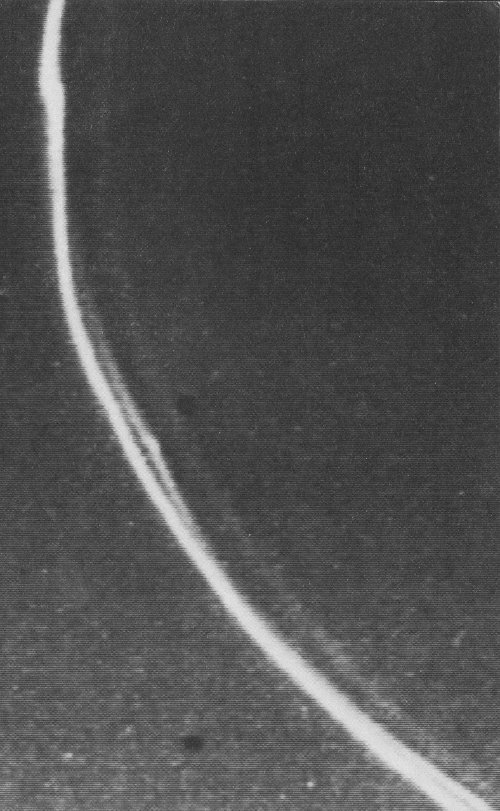
11/12/80 750,000 km (470,000 mi)
Two narrow, braided rings in the F-Ring are evident in this view, as well as a broader, very diffuse component about 35 kilometers (20 miles) across. A totally unexpected discovery, the braided rings trace distinctly separate orbits intertwining each other. The “knots” may be local clumps of ring material or tiny moons. It is difficult to explain this complicated structure using only the gravitational forces known to be affecting the particles of this ring. It is possible that additional, electrostatic forces may also influence these particles.
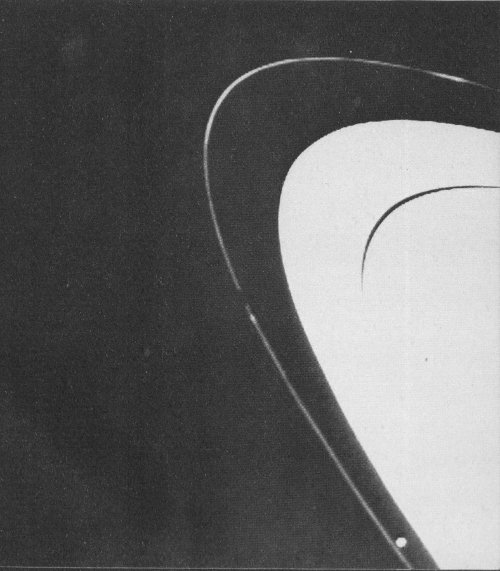
11/8/80 7 million km (4.3 million mi)
Brightness variations in the F-Ring may be due to clumping in the ring material. The features are seen at the top and again near the left edge of the ring in this image. The “gap” in the ring (left center) is not real but is the location of a reseau mark on the camera’s vidicon tube. These bright features in the F-Ring appear to move at the orbital rate of the ring particles and may be larger bodies or thicknesses in the rings. Saturn’s thirteenth and fourteenth satellites, which orbit on either side of the F-Ring, may act like “sheepdogs,” herding the F-Ring particles between them. Less than 100 kilometers (60 miles) wide, the F-Ring is located outside of the A-Ring. Satellite 14, discovered by Voyager 1, is seen just inside the F-Ring.
The Satellites
In only twelve hours, Saturn’s satellites grew from names in ancient mythology into dazzling worlds with personae of their own. As Voyager 1 sailed through the Saturn system, it returned photographs of Mimas, Enceladus, Tethys, Dione, and Rhea—all part of a class of intermediate-sized icy bodies heretofore unstudied by planetary spacecraft. All but Enceladus show heavily cratered surfaces, evidence of aeons of meteorite bombardment. Enceladus hints at internal processes, as yet unidentified, which may have erased from its surface the evidence of early bombardment—but we must await Voyager 2’s arrival next August to better understand this body.

11/9/80 4.5 million km (2.8 million mi)
The surface of giant Titan, now dethroned from its seat as the solar system’s largest satellite (Jupiter’s Ganymede is larger), remains an enigma, shrouded beneath thick layers of haze.
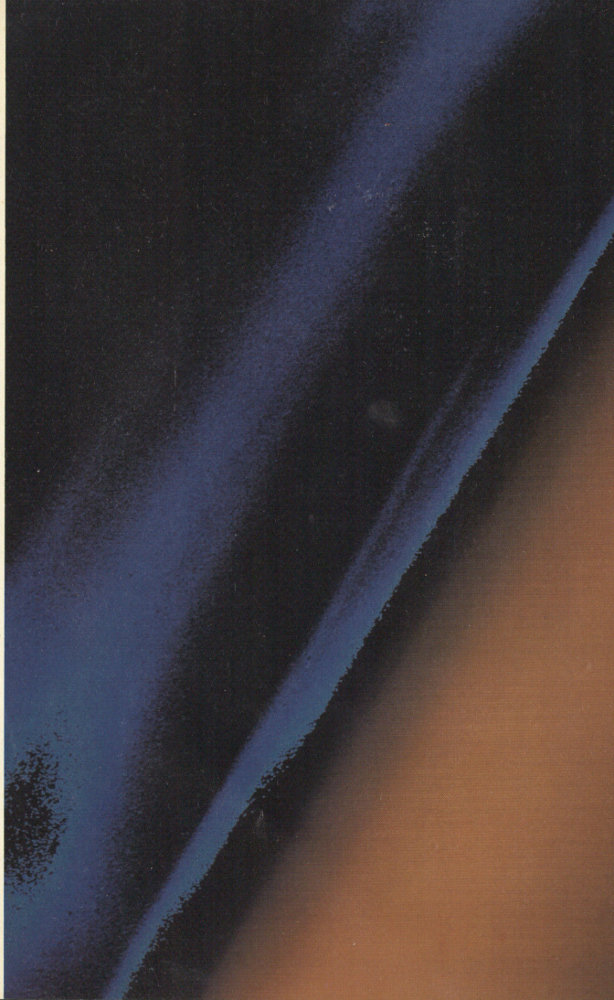
11/12/80 22,000 km (14,000 mi)
Tiny moons—three new ones and three confirmed from previous sightings—may tell us much about ring dynamics since gravitational forces from satellites probably influence the ring structure. Two of these tiny moons are on the verge of collision in the same orbit, while several others appear to bound the A- and F-Rings. Iapetus, whose two hemispheres differ dramatically in brightness, was photographed in its orbit, almost 3.6 million kilometers (2.2 million miles) from the planet.

11/12/80 425,000 km (264,000 mi)
Mimas, Saturn’s innermost large satellite, has an impact crater covering more than one quarter the diameter of the entire moon. Nowhere else in the solar system has such a disproportionately large feature been seen. In fact, it is believed that any impact larger than this would probably have shattered Mimas into two or more fragments. The crater has a raised rim and central peak, typical of large impact structures on terrestrial planets. Additional smaller craters, 15 to 45 kilometers (10 to 30 miles) in diameter, can be seen scattered across the surface, particularly along the terminator. Mimas is one of the small, low density Saturnian satellites implying that it is composed primarily of ice.
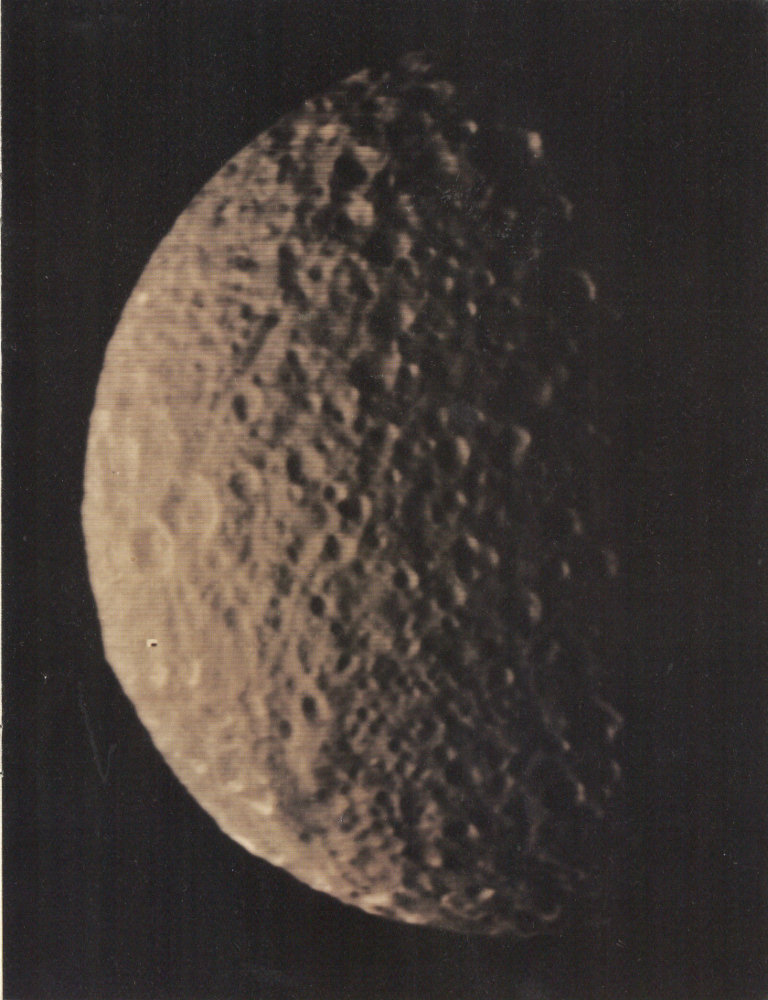
11/12/80 130,000 km (80,000 mi)
Mimas’ other side shows a uniformly and heavily cratered surface—a record of the bombardment that occurred throughout the solar system in its early history 4.5 billion years ago. A long, narrow trough about 5 kilometers (3 miles) wide crosses from northeast to southwest. Mimas’ surface is very reflective (about 60 percent), indicating that it consists largely of ice, which has been chipped and pulverized by aeons of meteoritic bombardment. Such a surface on a small, low mass moon would probably resemble light, powdery snow. Features as small as 3 kilometers (2 miles) across are visible.

11/12/80 650,000 km (400,000 mi)
Enceladus appears to be largely devoid of craters or other major surface relief, suggesting that perhaps internal processes may have erased such structures. This satellite will be seen better by Voyager 2 when it flies past Saturn in August 1981.
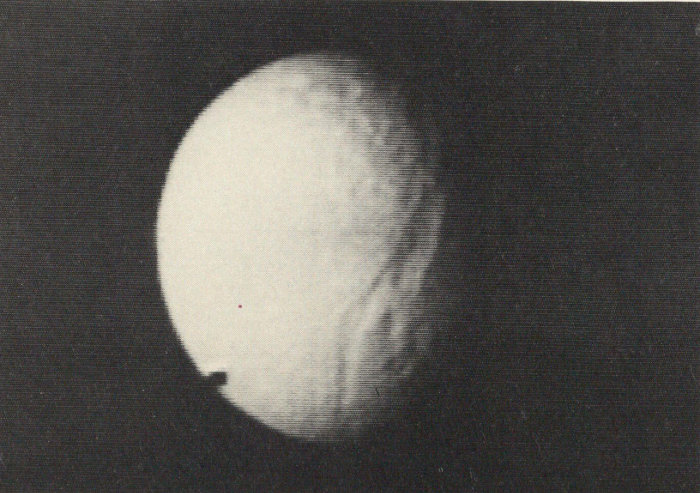
11/12/80 1.2 million km (750,000 mi)
This heavily cratered surface of Tethys faces toward Saturn and includes a large valley about 750 kilometers (500 miles) long and 60 kilometers (40 miles) wide. The craters are the result of impacts, and the valley appears to be a large fracture of unknown origin. Tethys has a diameter of 1050 kilometers (650 miles), about one-third that of Earth’s Moon. The smallest features visible in this picture are about 24 kilometers (15 miles) across.
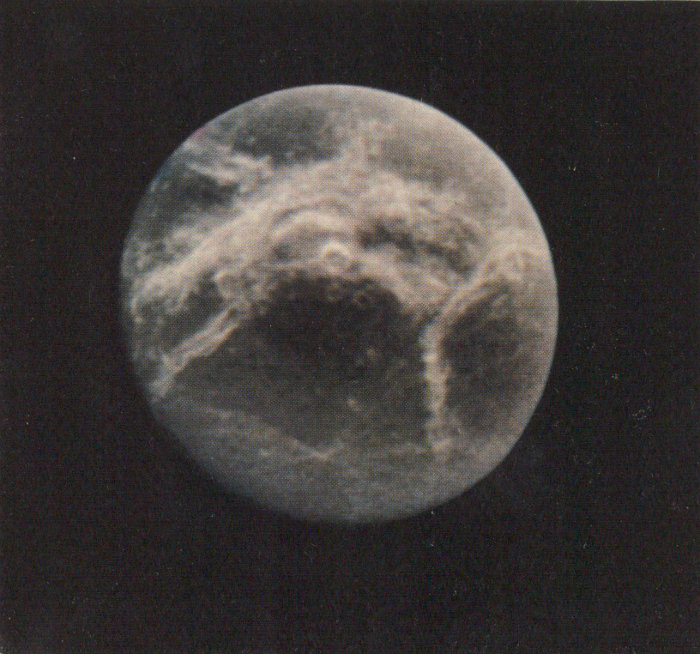
11/12/80 700,000 km (435,000 mi)
Dione reveals two distinctly different hemispheres. The photograph shows Dione’s trailing side. Bright radiating patterns are probably rays of debris thrown out of impact craters; other bright areas may be topographic ridges and valleys.
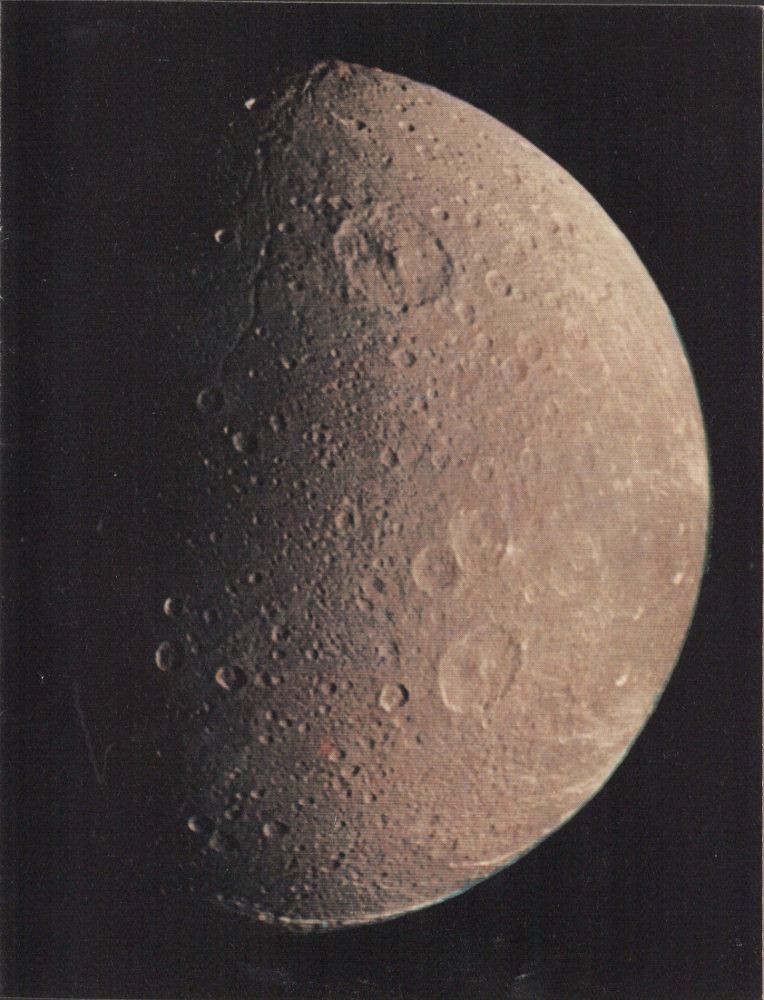
11/12/80 162,000 km (101,000 mi)
Dione’s other hemisphere (mosaic) also has many impact craters—the record of cosmic collisions. The largest crater is less than 100 kilometers (60 miles) in diameter and includes a well-developed central peak. Sinuous valleys (seen near each pole) are probably the result of crustal fracturing in the moon’s icy crust. Dione’s diameter is only 1100 kilometers (700 miles), much smaller than any of Jupiter’s icy moons.

11/13/80 80,000 km (50,000 mi)
Craters stand shoulder-to-shoulder on the surface of Saturn’s satellite Rhea, seen in this mosaic of the highest-resolution pictures of the north polar region. Rhea is 1500 kilometers (950 miles) in diameter and is the most heavily cratered Saturn moon. The largest crater, made by the impact of cosmic debris, is about 300 kilometers (190 miles) in diameter.
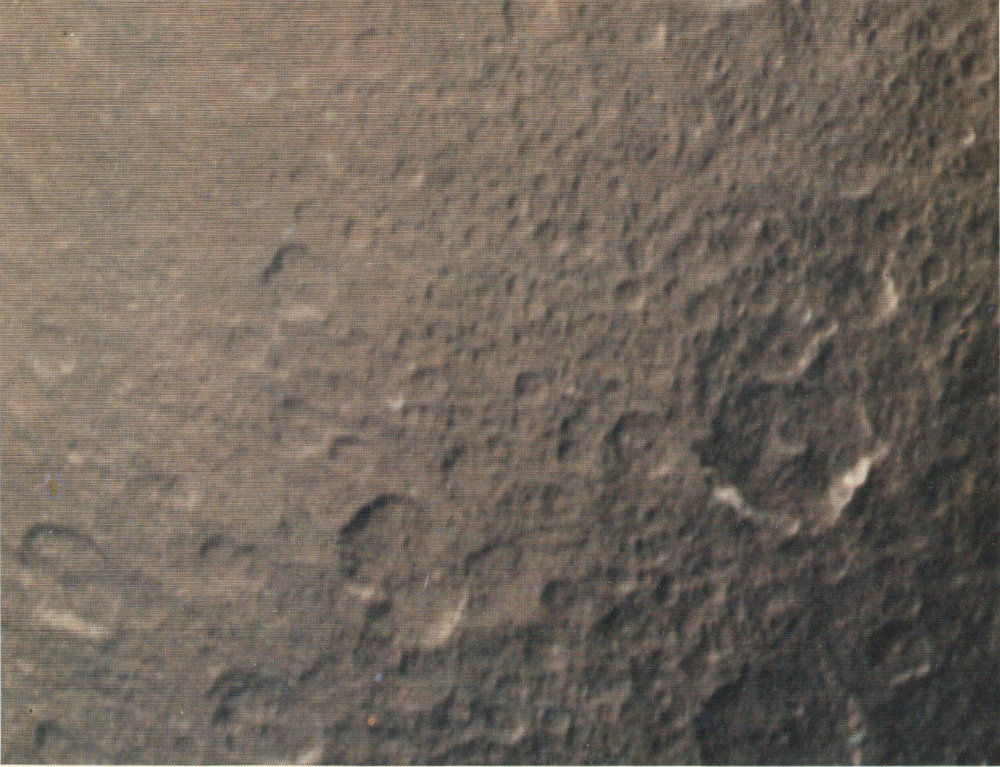
11/12/80 128,000 km (79,500 mi)
Impact craters on the ancient surface of Rhea closely resemble those on Mercury and Earth’s Moon. Many of the craters have central peaks formed by rebound of the floor during the explosive formation of the crater. Some craters are old and degraded by later impacts. Many have sharp rims and appear relatively fresh, while others are very shallow and have subdued rims, indicative of their antiquity. White areas on the edges of several of the craters are probably fresh ice exposed on steep slopes or possibly deposited by volatiles leaking from fractured regions. Surface features as small as 2.5 kilometers (1.5 miles) in diameter are visible.

11/9/80 4.5 million km (2.8 million mi)
Titan is a large, bizarre satellite. It is larger (almost 5120 kilometers or 3180 miles in diameter) than the planet Mercury and possesses a dense atmosphere of unique composition. Voyager 1’s cameras show Titan’s surface to be totally obscured by a thick layer of atmospheric haze. In the full-disk photograph, only two features are visible: a faint boundary between the southern and darker northern hemispheres and a dark “hood” overlying Titan’s north polar region.
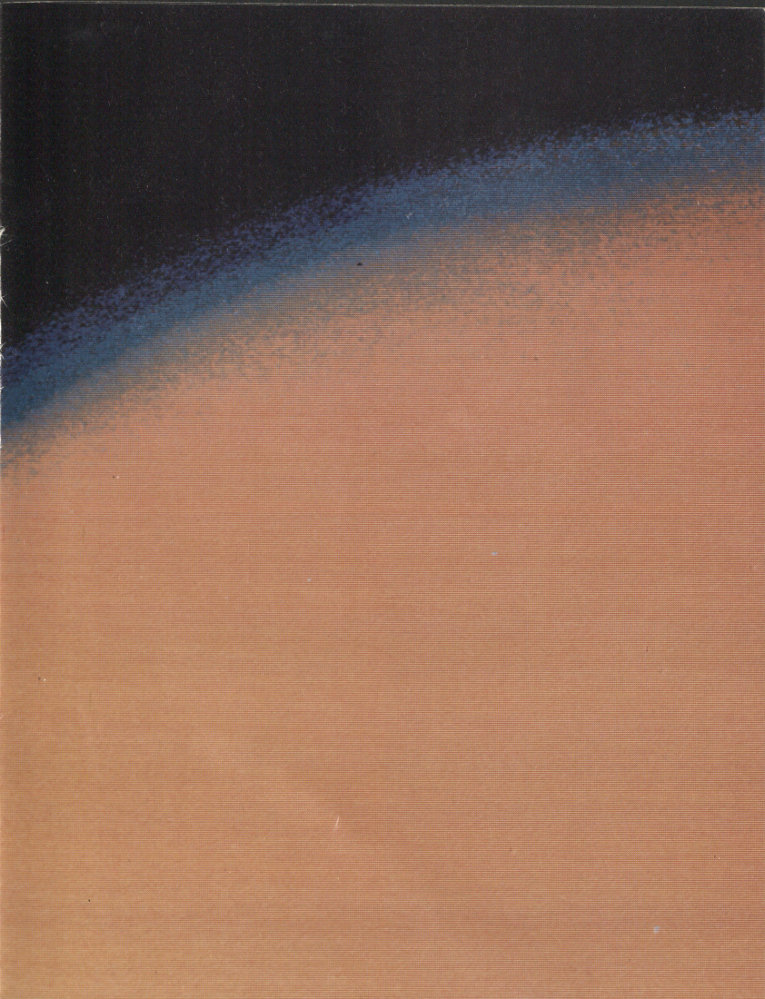
11/12/80 435,000 km (270,000 mi)
This hood and greater detail in the haze layers are shown in the higher resolution photograph.

11/10/80 4.6 million km (2.8 million mi)
Little detail can be seen in this distant view of Hyperion, the satellite which orbits just beyond Titan. Voyager 2 will observe Hyperion at a closer range.
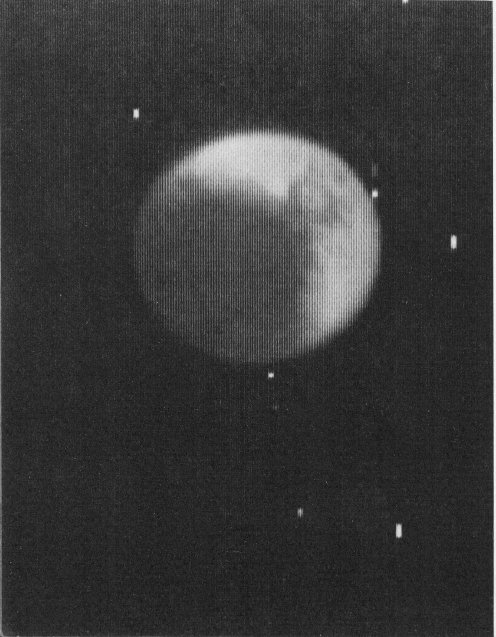
11/12/80 3.2 million km (1.9 million mi)
Saturn’s satellite Iapetus displays a large, circular feature about 200 kilometers (120 miles) across with a dark spot in its center. The circular feature is probably a large impact structure outlined by dark material, possibly thrown out by the impact. The satellite’s leading hemisphere is to the left, and the trailing hemisphere, which is four to five times brighter, is to the right. Iapetus’ diameter is 1450 kilometers (900 miles).
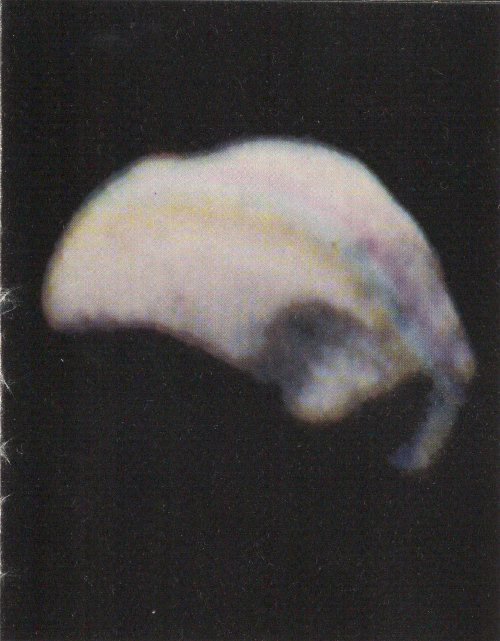
11/12/80 177,000 km (110,000 mi)
Two satellites (Saturn’s tenth and eleventh) revolve in nearly identical orbits 151,000 kilometers (94,000 miles) from Saturn’s center. The satellites are each 100 to 200 kilometers in diameter, larger than the distance separating their orbits, and they are currently approaching one another at a rate which promises collision in about two years. Such a collision, however, will probably be averted by orbital changes induced by the satellites’ mutual gravitational interactions as they near one another. The trailing co-orbital satellite, seen in this photograph, has a very irregular outline (the Sun is shining from the left). This color composite was produced from three exposures taken over a period of more than six minutes. During this period, a thin shadow, cast by a previously unknown ring, moved across the satellite causing the “rainbow” pattern shown here.
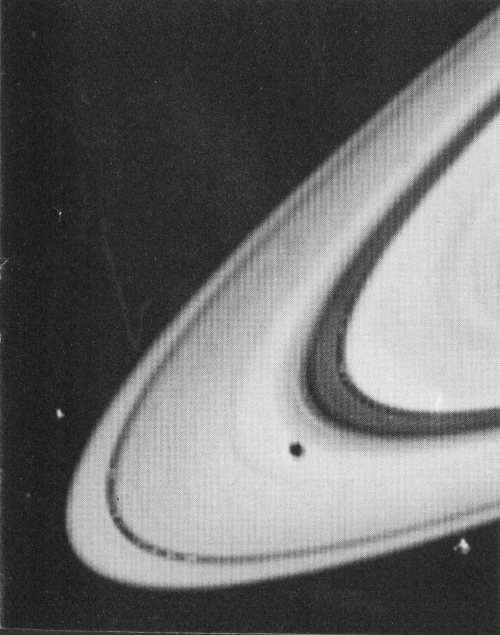
10/25/80 25 million km (16 million mi)
Two smaller satellites—Saturn’s thirteenth and fourteenth moons—were discovered on October 25, 1980, in images taken to study the dark “spokes” within Saturn’s B-Ring. The smaller, inner satellite has a diameter of about 500 kilometers (300 miles) and is visible just outside the A-Ring, near the bottom of the picture. It travels in an orbit between the A-Ring and the F-Ring (not visible in this photograph). The second satellite, seen to the left, travels just outside the F-Ring and is about 600 kilometers (400 miles) in diameter. Scientists believe the dimensions of the narrow F-Ring may be determined by these two satellites, which orbit on either edge of the ring.
A Glimpse Back

11/13/80 1.5 million km (930,000 mi)
Looking back at the Saturn system as it soared upward and outward, Voyager 1 continued its observations for nearly five weeks after closest Saturn approach. The spacecraft photographed the planet’s sunlit crescent, the ring shadows falling on the planet, and Saturn’s dark hemisphere illuminated by “ringshine.” It searched for lightning and auroras on the planet’s dark side and looked for “sun dogs” resulting from ammonia crystals in the atmosphere. It continued temperature and composition measurements and searched for new satellites out to the orbit of Mimas. It measured the flow of plasma in Saturn’s magnetosphere and now, its journey far from over, Voyager 1 proceeds toward the outer boundary of our solar system, as it seeks to probe the space among the stars of our galaxy, the Milky Way.
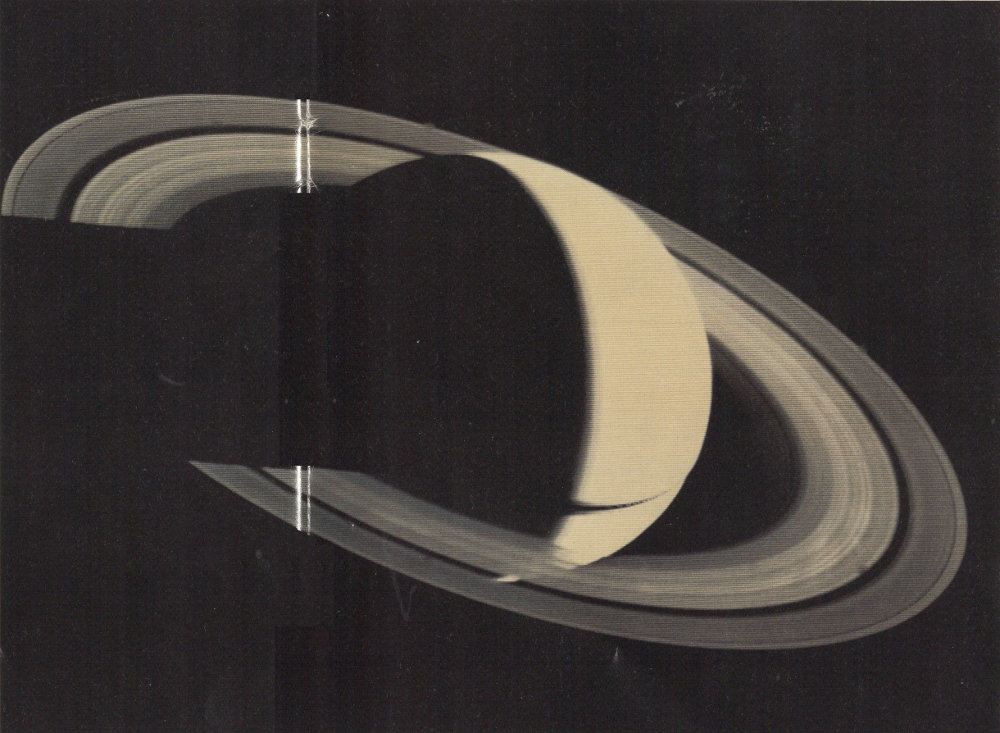
11/16/80 5.3 million km (3.3 million mi)
Departing Saturn, Voyager 1 photographed the planet from a unique perspective, clearly showing Saturn’s shadow on the rings.
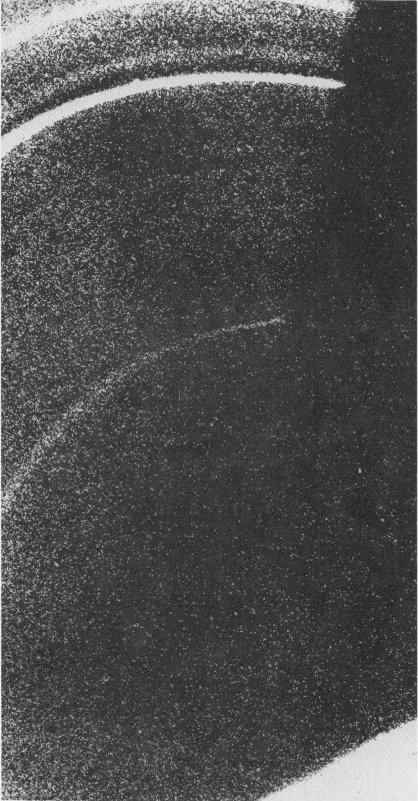
11/12/80 250,000 km (150,000 mi)
During a 40-minute period on the day of encounter, the spacecraft was itself in the planet’s shadow. At this time, the wide-angle camera acquired a photograph of this shadow line, revealing ring material in a region very close to the planet, where no material had been previously observed. This inner ring, the D-Ring, is roughly 6000 kilometers (4000 miles) wide and extends to within about 6000 kilometers of Saturn’s cloudtops.
The Voyager Mission
Only once every 175 years are the outer planets aligned in their orbits so that we can take advantage of gravity-assist trajectories to achieve encounters with Jupiter, Saturn, Uranus, and Neptune on one mission. The gravity-assist technique uses one planet’s gravity field and motion through space to alter the spacecraft’s flight path and propel it outward toward the next planet. Voyager 1’s trajectory, which was selected to best view Titan, has now propelled the spacecraft out of the ecliptic plane, while Voyager 2’s path will remain in this plane to provide future encounters with Uranus and possibly with Neptune.
MISSION OBJECTIVES
The Voyager Project was approved in June 1972 and had as its mission objectives:
- ★ Exploration of the Jupiter and Saturn planetary systems, including their atmospheres, rings, satellites, and magnetospheres
- ★ Comparative analyses of the two systems
- ★ Investigation of the interplanetary medium between Earth and Saturn
A fourth objective, added in 1976, was to preserve the possibility of extending the mission to include an investigation of the planet Uranus and the interstellar medium.
With the completion of Voyager 1’s Saturn flyby, it is now clear that these objectives will be achieved.
SPACECRAFT CHARACTERISTICS
Two identical spacecraft were developed for the 1977 launch opportunity. These marvelous machines were cleverly designed to survive the rigors of long voyages in outer space and to deliver high-quality scientific information required for detailed understanding of planetary systems. The spacecraft are both complex—automatically responding to their Earth-bound monitors that remotely control them via radio commands—and highly autonomous—capable of caring for themselves in many areas through a system of sensors, computers, and spare equipment. Each spacecraft functions on about 400 watts of electrical power which is provided by nuclear generators. Broadcasts of data across a billion miles to Earth are accomplished with a spacecraft transmitter power of only about 25 watts, the amount of energy required by a small household light bulb.
Voyager’s scientific payload was carefully chosen to observe Saturn over a wide range of wave-lengths and to measure magnetic fields, charged particles, and plasma waves.
SATURN ENCOUNTER

Voyager 1 approached within 124,000 kilometers (77,000 miles) of Saturn’s cloudtops. Six of the satellites that were photographed are shown in their approximate positions at closest approach by the spacecraft.
- TITAN
- DIONE
- TETHYS
- MIMAS
- ENCELADUS
- RHEA
Voyager 1’s Saturn encounter period began on August 22, 1980, at a range of 109 million kilometers (68 million miles) from the planet. Even at this great distance, Voyager’s images were better than any from Earth-based telescopes. During the long encounter period, which extended through December 19, 1980, continuous observations of Saturn’s realm were carried out by Voyager’s instruments. Voyager 1’s flight path through the Saturn system demanded navigation of the highest precision to meet three critical targets: (1) a close 4000-kilometer (2300-mile) flyby and occultation at Titan, (2) a precise, three-minute time period when the spacecraft was emerging from occultation at the same time Earth was in a position to receive the spacecraft signals passing through the gap between Saturn and its rings, and (3) a flight path through the E-Ring at Dione’s orbit to assure safe passage through a zone clear of potentially dangerous material. To assure these targets were achieved, small trajectory trim maneuvers were executed on October 11, 1980, and again on 37 November 6, 1980, as Voyager 1 sped toward Saturn.
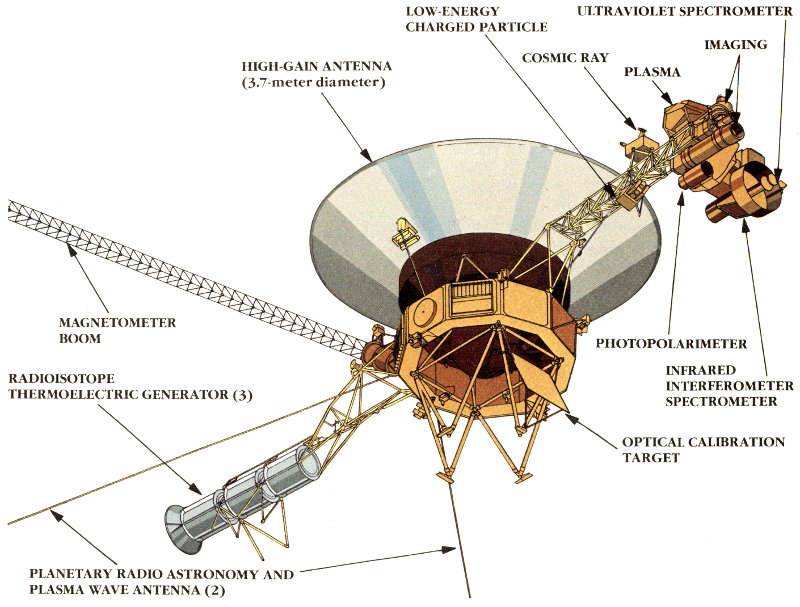
Voyager spacecraft and scientific instruments.
- HIGH-GAIN ANTENNA (3.7-meter diameter)
- LOW-ENERGY CHARGED PARTICLE
- COSMIC RAY
- PLASMA
- IMAGING
- ULTRAVIOLET SPECTROMETER
- INFRARED INTERFEROMETER SPECTROMETER
- PHOTOPOLARIMETER
- OPTICAL CALIBRATION TARGET
- PLANETARY RADIO ASTRONOMY AND PLASMA WAVE ANTENNA (2)
- RADIOISOTOPE THERMOELECTRIC GENERATOR (3)
- MAGNETOMETER BOOM
By October 24, 1980, when Voyager 1 was about 30 million kilometers (19 million miles) from Saturn, the spacecraft’s narrow-angle camera could no longer capture the planet in a single picture. Thus, a period of multiple images or mosaics began. By November 2, 1980, even four-picture mosaics could no longer cover the rapidly growing scene. Voyager 1’s pace of operations reached an exciting peak during the near-encounter phase from November 11 through November 13, 1980. While still about 1.6 million kilometers (1 million miles) from closest approach to Saturn, Voyager 1 encountered Titan on November 11, 1980, and then dipped below the ring plane as it accelerated rapidly toward Saturn. On November 12, 1980, Voyager 1 came within 124,000 kilometers (77,000 miles) of the cloudtops of Saturn’s southern hemisphere, where Saturn’s gravity altered the spacecraft’s course, hurtling the spacecraft upward past the ring plane. Close observation of Saturn’s other major satellites and its rings were made during this passage.
From Earth to Saturn, Voyager 1 has traveled in the ecliptic plane, the plane in which the major planets orbit. Now, having completed its final planetary flyby, Voyager 1 is rising above this plane on a trajectory that will eventually carry it above and out of the solar system, probably before the end of this century. As it proceeds, the spacecraft will return information about the solar wind and magnetic fields in the far, unexplored reaches of our solar system and will observe cosmic rays emitted from the distant stars among which Voyager will ultimately cruise.
Scientific Highlights
Some of the most important information gathered by Voyager 1 on the Saturn system is presented pictorially in this publication and is supplemented here with brief summaries of the major discoveries, observations, and theories.
SATURN
Saturn’s atmosphere appears similar to Jupiter’s, with alternating dark belts and bright zones, circulating storm regions, and other dark and light cloud markings. Saturn’s belt and zone system extends to higher latitudes than those on Jupiter, and all of the features are muted by a thick atmospheric haze, perhaps 70 kilometers (40 miles) deep.
Wind speeds up to 1500 kilometers per hour (900 miles per hour) occur at the equator—four to five times faster than any Jovian winds. Temperatures near the cloudtops range from 86 to 92 kelvins (-305° to -294° Fahrenheit)—nearly 60 degrees colder than at Jupiter. Saturn still radiates about 2.8 times as much heat as it receives from the Sun. The coolest temperatures are found at the center of the equatorial zone.
Auroral emissions have been seen near Saturn’s poles, and auroral-type emissions have been seen in ultraviolet light near the illuminated limb of the planet.
Lightning bolts have not been seen on Saturn, but radio emissions typical of lightning discharges have been recorded. The source of these discharges is believed to be the rings rather than Saturn’s atmosphere.
RINGS
Hundreds of tiny ringlets—a few of them elliptical rather than circular—comprise the classic A-, B-, and C-Rings, once thought to be uniform disks of material. The F-Ring, which was first sighted by Pioneer 11 in 1979, was observed to be three separate, intertwined ringlets.
The existence of a D-Ring between the C-Ring and the planet has been confirmed by observations during Voyager 1’s passage through Saturn’s shadow. The tenuous E-Ring, previously observed from Earth only when Saturn’s rings could be viewed edge-on (every 15 years), has also been observed during shadow passage. At least one other ring has been found between the E- and F-Rings in Voyager images.
Long, radial, spoke-like features in the B-Ring were dark when viewed upon approach and bright when observed after encounter when the spacecraft looked back toward the planet and the Sun.
NEW SATELLITES
Voyager 1 photographed six tiny moons, some that had never been seen before. Satellites 10 and 11, dubbed the “co-orbitals,” share an orbit 91,000 kilometers (57,000 miles) above Saturn’s cloudtops. The leading satellite has a diameter of about 160 kilometers (100 miles), while the trailing satellite has an irregular shape, approximately 105 by 65 kilometers (65 by 40 miles).
Little is known about satellites 12, 13, 14, and 15 aside from their orbits and periods. Satellite 12 orbits at the same distance from Saturn as Dione, at a point about 60 degrees ahead of Dione. Satellites 13 and 14, outside and inside the F-Ring (respectively), appear to “herd” this thin ring between them. Satellite 15 appears to limit the outer edge of the A-Ring in a similar manner.
INNER SATELLITES
Mimas, Enceladus, Tethys, Dione, and Rhea represent a body size not previously explored by spacecraft. They are larger than Jupiter’s Amalthea and Mars’ Phobos and Deimos, yet smaller than Mercury, our Moon, or Jupiter’s large satellites. Their diameters range from 390 kilometers (240 miles) for Mimas to 1530 kilometers (950 miles) for Rhea, and they are probably composed primarily of water ice.
With the exception of Enceladus, all of these moons have heavily cratered surfaces, looking much like the Moon and Mercury. Mimas displays an impact crater whose diameter is one-fourth that of the satellite—such an impact must have nearly shattered the icy satellite. Tethys has a valley 70 kilometers (40 miles) wide that stretches 800 kilometers (500 miles) across the satellite, an 39 apparent crustal fracture resulting from seismic activity. Several sinuous valleys, some of which appear to branch, are visible on Dione’s surface. Both Dione and Rhea have bright, wispy streaks on their already highly reflective surfaces, perhaps caused by ice thrown out of craters by meteorite impacts.
Of the five inner moons, Enceladus appears the smoothest, but we will have to wait for Voyager 2 to photograph the satellite at greater resolution in 1981. Since the maximum intensity of the E-Ring occurs near Enceladus’ orbit, Enceladus may be a source of E-Ring particles.
TITAN
Titan is now known to be smaller than Jupiter’s Ganymede. Its diameter is less than 5120 kilometers (3180 miles), which implies a density twice that of water ice. A dense, hazy atmosphere at least 400 kilometers (250 miles) thick obscures the surface. Voyager 1 determined that Titan has a nitrogen-rich atmosphere (as does Earth), but with concentrations of hydrocarbons such as methane (natural gas), ethane, acetylene, ethylene, and deadly hydrogen cyanide. The haze layers merge into a darkened hood over the north pole. At the poles, liquid nitrogen lakes may form. The surface temperature is probably near 100 kelvins (-280° Fahrenheit), only slightly warmer than the boiling point of liquid nitrogen.
Titan has no appreciable magnetic field and therefore possesses no large liquid conducting core. It does, however, supply a small amount of charged particles to Saturn’s magnetosphere.
The southern hemisphere is somewhat brighter than the northern, perhaps as a result of seasonal effects.
OUTER SATELLITES
Of the three known outer satellites, Voyager 1 studied from a distance only Hyperion and Iapetus. Tiny Phoebe, in its retrograde (clockwise) orbit, will be studied by Voyager 2 in the summer of 1981. Hyperion and Iapetus are most likely composed of water ice, although their masses and densities are uncertain. Iapetus has one bright and one dark hemisphere. The dark side, which faces forward as Iapetus circles Saturn, reflects about one-fifth as much light as the trailing, bright side.
MAGNETOSPHERE
Although it is only about one-third the size of Jupiter’s magnetosphere, Saturn’s magnetosphere is still an enormous structure, extending nearly two million kilometers from the planet toward the Sun. The size of the magnetosphere fluctuates rhythmically as the flow of charged particles in the solar wind increases or decreases in intensity. The magnetosphere can be pushed inside Titan’s orbit, so that at times the satellite finds itself outside of the magnetosphere altogether.
Charged particles in the planet’s magnetosphere are dragged along by the magnetic field, circling the planet at Saturn’s rotation rate of 10 hours, 39 minutes. These charged particles whiz by Titan at a dizzying rate of more than 200 kilometers (120 miles) per second. Titan leaves a motorboat-like wake in its orbital path.
Extending from the orbit of Titan inward to the orbit of Rhea, an enormous cloud of uncharged hydrogen atoms forms a doughnut-shaped torus of ultraviolet-emitting particles. Because of their neutrality, these atoms are not towed around by Saturn’s magnetic field.
Close to the planet, Saturn’s rings act as an effective shield or absorber of charged particles. The rings themselves are apparently substantially affected in this process, however, as evidenced by their “spokes” of fine particles and the lightning-like electrical discharges attributed to the rings.
Scientific Investigations
| INVESTIGATION | SATURN ENCOUNTER OBJECTIVES |
|---|---|
| Imaging science | Planetary meteorology; satellite geology; ring structure and dynamics |
| Infrared interferometry | Atmospheric composition, thermal structure and dynamics; satellite surface composition and thermal properties; ring composition |
| Radio science | Atmospheric and ionospheric structure, constituents, and dynamics at Saturn and Titan; ring particle size |
| Ultraviolet spectroscopy | Upper atmospheric composition and structure; auroral processes; distribution of ions and neutral atoms in the Saturn system |
| Magnetic fields | Planetary magnetic field; magnetospheric structure |
| Plasma particles | Magnetospheric ion and electron distribution; solar wind interaction with Saturn; ions from satellites |
| Plasma waves | Plasma electron densities; wave-particle interactions; low-frequency wave emissions |
| Planetary radio astronomy | Polarization and spectra of radio-frequency emissions; plasma densities |
| Low-energy charged particles | Distribution, composition, and flow of energetic ions and electrons; satellite-energetic particle interactions |
| Cosmic ray particles | Distribution, composition, and flow of high-energy trapped nuclei; energetic electron spectra |
“Notre voyageur connaissait merveilleusement les lois de la gravitation, et toutes les forces attractives et répulsives. Il s’en servait si à propos, que tantôt à l’aide d’un rayon de soleil, tantôt par la commodité d’une comète, il allait de globe en globe, lui et les siens, comme un oiseau voltige de branche en branche.”
“Our voyager knew marvelously the laws of gravitation, and all attractive and repulsive forces. He used them in such a timely way that, once with the help of a ray of sunshine, another time thanks to a cooperative comet, he went from globe to globe, he and his kin, as a bird flutters from branch to branch.”
VOLTAIRE—Micromégas, Histoire Philosophique, 1752.

National Aeronautics and Space Administration
Jet Propulsion Laboratory
California Institute of Technology
Pasadena, California
JPL 400-100 12/80

